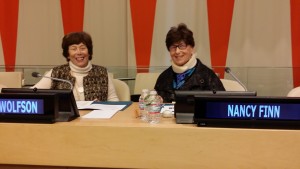Providing apropriate health care is a challenge in remote areas of developing and developed nations, where skilled professional health personnel and facilities are limited. However, e-health, with tools to redesign care models around the common needs of discrete patient populations, is saving lives every day, and serving as a spring-board for further progress.
I spoke recently at the fifty-ninth session of the Commission on the Status of Women at the United Nations, Symposium, sponsored by the Global Alliance for Women’s Health. The main focus of the session was tied to the Beijing Declaration and Platform for Action and two of the most compelling Millennium Development Goals (MDGs), incorporated in that report which seek specifically to reduce maternal and infant deaths by 2015.
The Bejing+20 report, based on a 64-country survey, demonstrates, as never before, the vital role e-health and information and communication technologies (ICTs) play in achieving the current challenges: gender equality, empowerment of women, and the improved health of women and children.
In my presentation, I outlined how innovative approaches that deploy ICT can be used to increase patient engagement, close communication gaps and provide viable live-saving solutions. I also described many of the digital technologies that are now available, including:
Mobile devices and remote chronic care monitoring apps;
Telemedicine, using voice, data, text, imaging and video, to enable virtual second opinions and consultations and office visits;
Data mining tools and cloud computing that hold enormous amounts of data for retrieval and analysis;
The internet with its vast array of resources and social networks,
Digitized health records that provide the communication bridges between providers and consumers and insure that a patient’s full information is available at the point of care.
I discussed the fact that Internet and mhealth have become almost indispensable, commonplace instruments of change for a huge and growing segment of the population around the world. Already, well over 100 countries are using mobile phones to achieve better health. Internet access is expanding everywhere.
The ITU (International Telecommunications Union, a UN Agency) estimates that, by the end of 2014, almost 3 billion people were using the Internet, corresponding to a global penetration rate of 40.4 per cent. This compares to 38 percent penetration a year earlier, and 30 percent penetration just four years earlier. There are still 4.3 billion people worldwide who are not yet using the Internet, 90 per cent of whom live in the developing world. In developed countries more than three people for every person are online; in the developing nations it is one out of three. The ITU also reports that 98% of the world’s population have cellphones, although not so much in many developing nations.
There are, some encouraging stories. Several developing countries are beginning to use e-Health technology to create registries for births, deaths and cause of deaths, which is a significant step toward understanding general trends and patterns in population health.
Deployment of telemedicine, teleconsulting and other ways of achieving remote access from central urban based health facilities out to health workers and patients has also had a significant impact on maternal, neonatal and pediatric care. Telemedicine technology is being deployed in Austria, Belgium, Finland and Germany for management of chronic conditions; in Ghana for fostering Communication among physicians; in Northern Pakistan for enabling collaboration among community health centers, and in Cameroon for monitoring patients with hypertension
Short Message Systems texted or sent as voice messages to mobile phones are improving health in virtually all settings, large and small, urban and rural. SMS technology is cost efficient, easy to set up and maintain and has the broadest possible reach. It is a way to get out messages to the general population about non-communicable and communicable diseases; a way to encourage people to be more engaged and proactive in their health; to recognize the reasons for and the actions to be taken for better health. Short messages offer advice on specific conditions and on general health and wellness issues such as nutrition, alcohol, tobacco, drug use, as well as and early warnings about potential epidemics, immunizations and disaster recovery. SMS requires virtually little or no training of health workers.
In Bangladesh, where 98% of the population has a cellphone, SMS has been used to increase awareness of general health issues about vaccinations, immunizations, information on breast feeding, prenatal and postnatal care and more.
In South Africa. where the incidence of HIV/ AIDs is higher than anywhere in the world and where the stigma is so great that people will not go to the health clinic to get a test kit, SMS messages in the local language, sent daily to a million mobile phones are instructing people to call the national hotline and ask for a test kit that can be used at home, in private. SMS is also being used in South Africa and elsewhere to instruct people and their health workers on medication adherence, how to monitor HIV/AIDS and when medical interventions are needed. The South Africa campaign is the largest outreach SMS campaign in the world and indicates the promise of a future where SMS will make a difference in health outcomes, one message at a time.
Exciting things are happening. Empowering patients, especially women patients, to understand their right to basic health services, and educating them to gather information, engage in communication and use technology, will foster better health outcomes for everyone. We have come a long way and we have more to do. At the UN great efforts are underway to get to the finish line.







Recent Comments